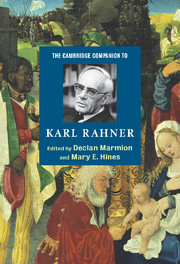Book contents
- Frontmatter
- Introduction
- Part I Spiritual, Philosophical, and Theological Roots
- Part II Theological Investigations
- 4 Method in theology
- 5 Revelation and faith
- 6 Trinity
- 7 Christology
- 8 Ecclesiology and ecumenism
- 9 Ministry and worship
- 10 Ethics
- 11 Eschatology
- Part III Conversations Ongoing
- Part IV Retrospect and Prospect
- Appendix
- Index
4 - Method in theology
from Part II - Theological Investigations
Published online by Cambridge University Press: 28 May 2006
- Frontmatter
- Introduction
- Part I Spiritual, Philosophical, and Theological Roots
- Part II Theological Investigations
- 4 Method in theology
- 5 Revelation and faith
- 6 Trinity
- 7 Christology
- 8 Ecclesiology and ecumenism
- 9 Ministry and worship
- 10 Ethics
- 11 Eschatology
- Part III Conversations Ongoing
- Part IV Retrospect and Prospect
- Appendix
- Index
Summary
Karl Rahner developed his theology and method within the shift taking place in theology between Vatican I and Vatican II. In that period, neo-Thomist theology permeated much of academic theology. The growing influence of scriptural, patristic, liturgical, and philosophical studies began to dismantle the neo-Thomist approach and to prepare the way for Vatican II. Karl Rahner was both influenced by these advances and was a leading figure in their development in the period before and after the Council. Today, however, another significant shift is taking place. The aftermath of the Second Vatican Council saw not only the implementations of the Council, but also many multi-sided criticisms. The Right maintained that the Council went too far, whereas the Left claimed that the Council did not go far enough. From the perspective of post-liberalism, Vatican II went too far, was too progressive, and surrendered too much of the tradition for the sake of modernity. From the perspective of the various liberation, feminist, post-colonial, and pluralist theologies, the Council was too embedded within a European mentality whose patriarchalism and colonialism constitute the undersides of Western modernity. Consequently, the current scene is one of theological conflict, disagreement, and controversy.
These shifts are important for interpreting Karl Rahner’s method. As the cultural climate has changed from an openness to modern philosophical values to a critical caution toward modernity and to an embrace of postmodern values, so too the assessment of Karl Rahner’s method has changed.
- Type
- Chapter
- Information
- The Cambridge Companion to Karl Rahner , pp. 65 - 82Publisher: Cambridge University PressPrint publication year: 2005

